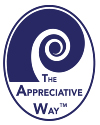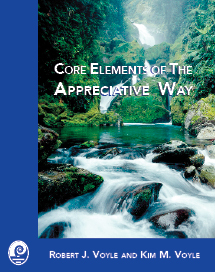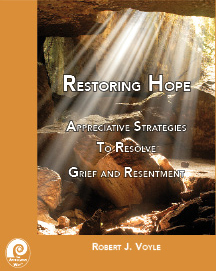

The Appreciative Way
Restoring HopePractical Appreciative Inquiry based strategies to effectively resolve grief and resentment. Stay ConnectedReceive The Appreciative Way our Free Email Newsletter Subscribers receive monthly Appreciative Tips and advanced notification of our upcoming Training Programs. Privacy: We never rent, sell, or share your email. |
Steve AndreasSteve Andreas along with his wife, Connirae, are innovators, developers, and exponents of Neuro-Linguistic-Programming, (NLP), which was initially influenced heavily by the work of Milton Erickson. In contrast to Erickson's work which is obscure and full of mystery which makes it hard to learn or replicate, Andreas' work is very transparent and learnable. The Andreas have produced many resources with step by step protocols to create sustainable change and resolve specific problems such as PTSD, phobias, grief and resentment. The Appreciative Way relies heavily on the Andreas' work for the fine technical skills and details of creating sustainable change. For example in the field of Appreciative Inquiry we say that"people grow toward their images of the future." What Steve's work does is provide specific ways to modify and transform a person's image of the future. In particular when creating change the Appreciative Way relies heavily on two things we learned from Steve Andreas:
Understanding and Changing the Structure of Experience to Create Change There are two elements to any memory that we hold in consciousness:
The content of a memory is simply the story of what happened. The structure relates to how we are representing the memory in consciousness. For example: some will "see a picture," others will "hear the sounds and dialogue," others will "just have a sense or feeling about what happened" and some may also have "tastes and smells" associated to the memory. Within the visual, auditory, and kinesthetic modes of representation, memories may also have submodality aspects such as: size, intensity, color, and location. For example a person's "picture" of a person they care about may seem to be "closer" than the picture of a person they don't care about. Older memories when visualized are likely to be small and blurred in contrast to more recent visual memories. In contrast old visual memories of unresolved trauma are likely to be large and colorful and much closer to the person. When we "resolve" a past memory we cannot change the content of the experience, for that would be to create a delusion. We could change the perspective from which the past is viewed, for example from the perspective of a victim or a survivor. Or we can change the structure of the memory. We can change the size of pictures or the loudness of sounds. We can also change the location of pictures or sounds in consciousness, and any other aspect of the way it is represented. What people find is that changing the structure of experience is a way to create fast and sustainable resolution of problems. Surprisingly these changes can be created without any reference to the content of the experience. Rob Voyle's book Restoring Hope: Appreciative Strategies to Resolve and Grief and Resentment relies heavily on Steve and Connirae's grief and forgiveness processes which rely on restructuring the experience of grief and resentment. Ensuring Change is Ecological Many people have had the experience of making a change only to fall back into the old way of behaving. Such events suggest the desired outcome wasn't sustainable or ecological. There are several reasons why this may occur:
None of us is entirely committed to anything. We have competing demands on our time and actions. We may also have competing values such as a desire for freedom and a desire to belong. Whenever we make a change some part of us is likely to object. One strategy to deal with the objection is to ignore or overcome it. Unfortunately overcoming an object is a violent assault on our psyche and is likely to elicit a violent or passive aggressive response that sabotages the outcome. Rather than overcome the objection we need to seek it out and intentionally satisfy the objection. For example when a person is moving across country for a new job some part of them may object to the change because they will lose their friends or family. Satisfying that objection may include committing to a "trip back" once a year to be with friends and ensuring that the house they purchase in the new location has a guest bedroom where friends can come and stay. Changes that violate the Golden Rule are also not likely to be sustainable as they will often evoke a hostile response from the environment. Ensuring that no one is deprived of what is life-giving to them as we pursue what is life-giving to us is critical to creating just and sustainable outcomes. Steve Andreas has written many books which can be found at: Real People Press
>>
Read more on the work of Steve Andreas >>
Read more on the synthesis of the Andreas' work and the Appreciative Way |
|---|

